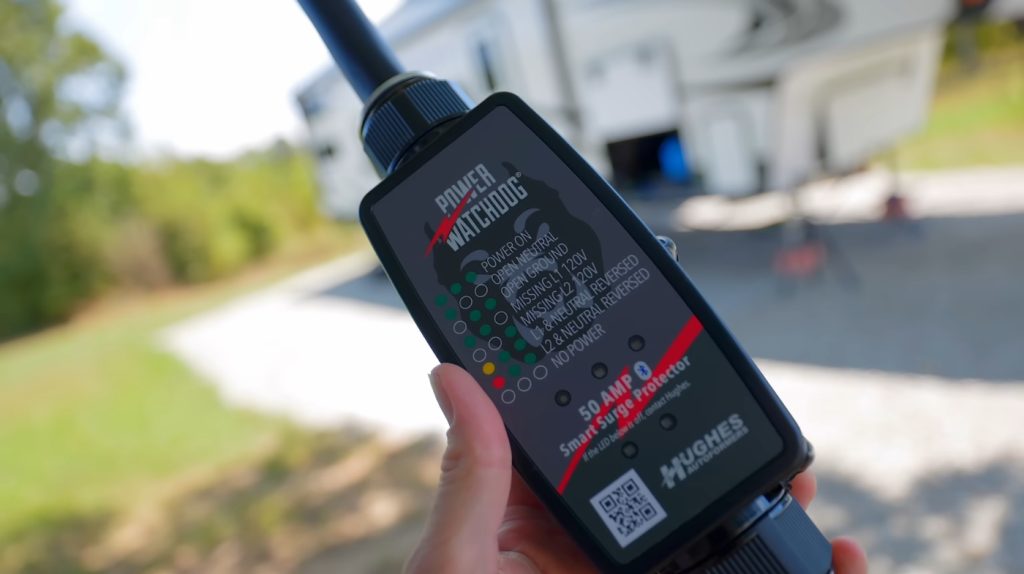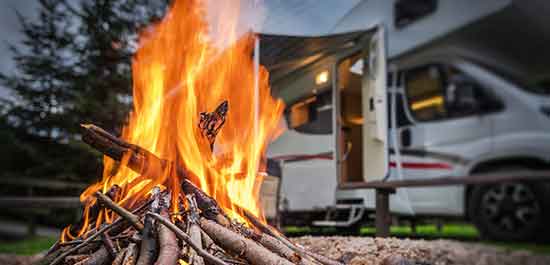Last Updated on April 28, 2025
You do need a surge protector for your RV to protect your electrical system from voltage spikes caused by lightning, faulty campground wiring, or appliance surges. Without one, sensitive components like converters and appliances risk damage, potentially leading to costly repairs.
Surge protectors provide real-time voltage monitoring, fault detection, and automatic shutdown features, ensuring safer power use. Understanding the types, installation, and benefits of surge protection will help you secure your RV’s electrical safety more effectively.
Key Takeaways
- Surge protectors prevent damage to your RV’s sensitive electronics from voltage spikes and electrical surges common at campgrounds.
- They detect wiring faults and unsafe pedestal conditions, reducing the risk of electrical fires and equipment damage.
- Using a surge protector extends the lifespan of appliances by ensuring a stable and clean power supply.
- Portable and hardwired surge protectors are available, so you can choose based on your RV’s electrical system and camping style.
- Regular use of a surge protector is a cost-effective way to avoid expensive repairs caused by unpredictable electrical surges.
Importance of Protecting Your RV’s Electrical System
Because your RV relies heavily on its electrical system for functionality and comfort, protecting it against voltage spikes and wiring faults is essential to prevent damage and guarantee safety.
Surge protectors shield sensitive electronics and appliances from abrupt voltage increases that can cause costly failures. Faulty wiring or unaddressed electrical surges increase the risk of fires and system breakdowns, making early detection and prevention critical.
Protect your RV’s electronics from voltage spikes and wiring faults to prevent costly damage and fire risks. Installing high-quality surge protectors not only safeguards components but also helps identify wiring issues like malfunctioning outlets. Many surge protector models also feature locking systems to prevent theft and tampering, adding an extra layer of security.
Regular maintenance including inspecting cords, circuit breakers, and Ground Fault Circuit Interrupters (GFCIs)—ensures continued protection against electrical hazards.
Additionally, choosing models with comprehensive diagnostic functions can detect potential issues before they cause damage. This proactive approach extends the electrical system’s lifespan and maintains operational reliability, providing you with peace of mind during your travels.
How Electrical Surges Occur in RV Environments?
When maneuvering an RV’s electrical system, you must understand that electrical surges stem from various environmental and operational factors. Voltage spikes can occur due to lightning strikes near campgrounds or power lines, creating sudden high-voltage events.
Additionally, starting or stopping large appliances and HVAC units generates transient voltage changes that stress the system. Power grid operations, such as load balancing, cause brief fluctuations at campground pedestals.
Human errors like improper plugging or unplugging devices introduce artificial surges, while faulty wiring in pedestals or RV circuits destabilizes voltage. Key causes include:
- Lightning-induced voltage spikes
- Transient surges from appliance operation
- Power grid switching fluctuations
- Improper device connection procedures
- Faulty or damaged wiring in power sources
Key Features to Look for in an RV Surge Protector
You need to prioritize essential protection features like:
Essential Protection Features
Although RV electrical systems vary, selecting a surge protector with essential features guarantees reliable defense against power irregularities. You need a device that not only defends against voltage spikes but also continuously monitors electrical conditions and detects wiring faults to avoid damage.
This is especially important because sensitive electronic devices powered by the RV’s electrical system are particularly vulnerable. Key components like metal oxide varistors (MOVs) absorb excess voltage, while circuit boards analyze power quality in real time.
Thermal fuses add safety by preventing overheating. Prioritize a surge protector with a high joule rating to make certain it can handle substantial energy surges without failure. Look for these features:
- Surge protection to block voltage spikes
- Voltage monitoring for steady power supply
- Wiring fault detection (open ground, reverse polarity)
- MOVs to absorb excess voltage
- Thermal fuses to prevent overheating and fire risks
Installation and Compatibility
Selecting an RV surge protector involves more than just evaluating its protective capabilities; installation methods and system compatibility play a pivotal role in guaranteeing ideal performance.
You must match the surge protector’s amperage rating—typically 30 or 50 amps—to your RV’s electrical system and confirm voltage compatibility, usually 120V. Check plug types, such as TT-30 or 14-50, to guarantee seamless connections.
Installation varies: portable units plug directly into the pedestal, while hardwired models require precise wiring between the power inlet and RV panel, demanding tools like wire strippers and a multimeter. Proper mounting in dry, accessible locations prevents damage and facilitates maintenance.
It is important to ensure that power is completely off before starting installation to avoid electrical hazards, including turning off breakers and unplugging the power cord.
Additionally, advanced units monitor voltage irregularities and disconnect power during faults, enhancing compatibility with your RV’s electrical components, including inverters and solar systems.
Types of RV Surge Protectors and Installation Options
When evaluating protection for your RV’s electrical system, understanding the various types of surge protectors and their installation options is essential.
You can choose from basic surge protectors, which offer fundamental surge defense, to advanced Electrical Management Systems (EMS) that monitor and safeguard against voltage irregularities, open grounds, and reverse polarity.
EMS units act as an insurance policy for your RV’s electrical safety by protecting against a wider range of electrical issues. Portable models provide flexibility for use across multiple RVs, while hardwired units integrate permanently into your electrical system.
Blended models combine surge protection with monitoring and connectivity features for enhanced control. Key points to evaluate:
- Basic vs. EMS protection level and scope
- Portable for ease of use vs. hardwired for permanence
- Compatibility with 30-amp or 50-amp systems
- Features like Bluetooth, digital displays, or time delay reset
- Installation complexity and required tools for each type
Potential Risks of Operating Without Surge Protection
Operating your RV without a surge protector exposes your electrical system to multiple significant risks, including damage from power surges, voltage irregularities, and faulty campground wiring.
Power surges and voltage spikes can instantly destroy sensitive components like converters, inverters, and HVAC systems, while undervoltage conditions degrade appliances over time.
Faulty or miswired campground pedestals increase exposure to unstable voltage, elevating the risk of electrical faults. These irregularities can cause overheating, potentially igniting fires inside your RV.
Additionally, repeated power fluctuations stress electrical equipment, accelerating wear and causing operational disruptions such as unexpected air conditioner cycling and emergency shutdowns of onboard systems.
Without surge protection, you leave your RV vulnerable to costly repairs, safety hazards, and reduced lifespan of critical electrical components.
Advantages of Using a Surge Protector While Camping
Although camping environments vary widely, using a surge protector provides critical advantages by safeguarding your RV’s electrical system from voltage irregularities. It blocks damaging power surges, undervoltage, and detects wiring faults, preserving appliance integrity and operational lifespan.
You gain real-time monitoring that alerts you to electrical anomalies, enhancing safety and enabling proactive maintenance. Immediate power cutoff during dangerous conditions prevents fire hazards and costly repairs.
This investment greatly reduces downtime and protects expensive components, proving cost-effective over time. Additionally, surge protectors are essential for maintaining the longevity of the RV’s electrical system as RVs connect to various power sources, increasing surge susceptibility.
- Guards appliances against spikes, drops, and lightning-induced surges
- Monitors voltage, current, and frequency with real-time diagnostics
- Automatically shuts off power on detecting hazardous electrical faults
- Extends equipment longevity by ensuring stable electrical supply
- Offers portable or hardwired options tailored to your camping needs
Frequently Asked Questions
Can a Surge Protector Drain My RV Battery When Not Plugged In?
You might think a surge protector quietly saps your RV battery when it’s unplugged, but that’s not the case. Surge protectors don’t draw power from your battery when disconnected; they only operate when plugged into shore power.
However, if low voltage triggers the protector to shut off while connected, your battery could power some systems, indirectly causing drain.
How Often Should I Test or Replace My RV Surge Protector?
You should test your RV surge protector at least once a year and after any major power event or electrical storm to catch early issues. Monitor built-in indicator lights regularly for faults. Replace it if it’s absorbed a large surge, shows visible damage, constant tripping, or fails indicator lights.
Frequent power fluctuations or exposure to harsh conditions may require more frequent inspections and earlier replacement to maintain reliable protection.
Are Surge Protectors Effective Against Low-Voltage Brownouts?
Think of surge protectors as lightning rods, built to divert sudden voltage spikes—not as shields against the slow, creeping shadow of brownouts. They won’t catch low-voltage dips or sags, so they’re ineffective during brownouts.
For that, you need a voltage regulator or UPS, which stabilize power flow and prevent damage. Surge protectors help after brownouts when voltage surges spike, but they don’t address the core problem of sustained low voltage.
Can I Use a Home Surge Protector With My RV?
You shouldn’t use a home surge protector with your RV because residential units aren’t designed for RV electrical systems. They often can’t handle 30-amp or 50-amp configurations, miss campground wiring faults like reversed polarity or open grounds, and lack protection against voltage fluctuations common in mobile setups.
RV surge protectors are specifically engineered for your rig’s power needs, safety, and harsh outdoor conditions, ensuring thorough, reliable protection you won’t get from home devices.
Do Surge Protectors Interfere With RV Solar Power Systems?
Think of your RV’s surge protector and solar power system as two teammates playing different positions—they don’t step on each other’s toes. Your surge protector safeguards the AC shore power by managing voltage spikes and wiring faults, while your solar system runs an isolated DC circuit.
Since these systems operate in parallel without direct interaction, the surge protector won’t interfere with solar charging, but protecting your inverter during DC-to-AC conversion remains essential.
Choosing the Right Surge Protector for Your RV
You absolutely need a surge protector for your RV—without one, electrical surges could fry your system faster than a lightning bolt striking metal. Protecting your RV’s electrical components isn’t optional; it’s critical to avoid costly damage and downtime.
By choosing the right surge protector with essential features and proper installation, you guarantee reliable, safe power. Don’t gamble with your RV’s electrical integrity—invest in surge protection and camp confidently every time.



